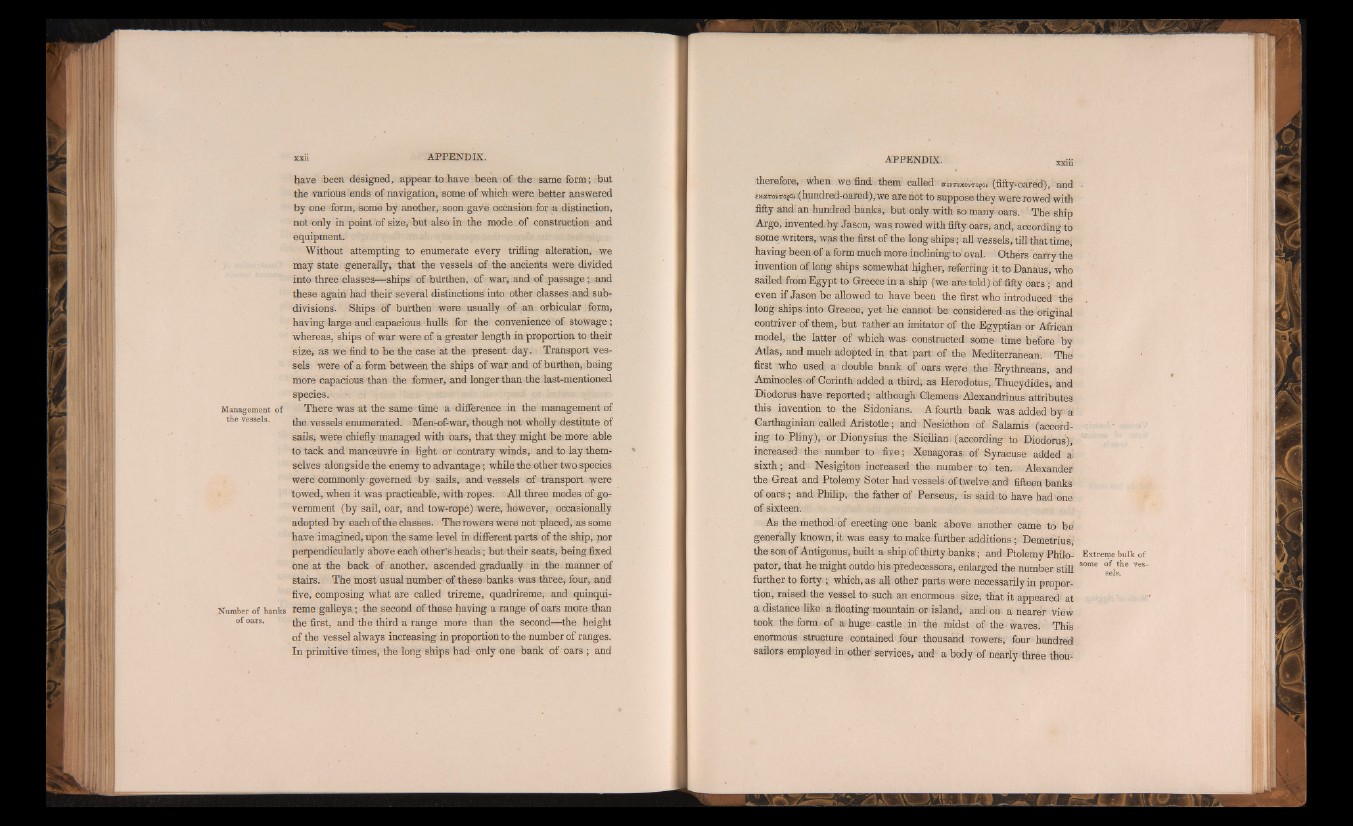
Management of
the vessels.
Number of banks
of oars.
have been designed, appear ta have been of the same form ; but
the various ends of navigation, some of which were better answered
by one form, some by another, soon gave occasion for a distinction,
not only in point of size, but also in the mode of construction and
equipment.
Without attempting to enumerate every trifling alteration, we
may state generally, that the vessels of the ancients were divided
into three classes—ships of biirthen, of war, and o f passage ; and
these again had their several distinctions into other classes and subdivisions.
Ships of burthen were usually of an orbicular form,
having large and capacious hulls for the convenience of. stowage ;
whereas, ships of war were of a greater length in proportion to their
size, a s we find to b e the c a s e àt the present day. Transport vessels
were of a form between th e ships of w ar and of burthen, being
more capacious th an the former, and longer than the last-mentioned
species.
T h e re was a t the same time a difference in the management of
the vessels enumerated. Men-of-war, though not wholly destitute of
sails, were chiefly managed with oars, that th ey might b e more able
to tack and manoeuvre in light o r contrary winds, and to lay themselves
alongside the enemy to advantage ; while the other two species
were commonly governed b y sails, and vessels of transport were
towed, when it was practicable, with ropes. All three modes of government
(by sail, oar, and tow-rope) were, however, occasionally
adopted b y each of the classes. The rowers were not placed, as some
have imagined, upon the same level in different parts of the ship, nor
perpendicularly above each other’s heads ; but their seats, being fixed
One a t the back of another, ascended gradually in the manner of
stairs. The most usual number of these banks was three, four, and
five, composing what are called trireme, quadrireme, and quinqui-
reme galleys ; the second of these having a range of oars more than
the first, and the third a range more than the second—the height
of the vessel always increasing in proportion to the number of ranges.
In primitive times, the long ships had only one bank of oars ; and
GSM. mi HH9S9 i r a
APPENDIX. xxiii
therefore, when we find them called nevvexovrogoi (fifty-oared), and
£K«TO«»gft (hundred-oared ), we are riot to suppose they w ere rowed with
fifty and an hundred banks, but only with so many. oars. The ship
Argo, invented, by Jason, was rowed with fifty oars, and, according to
some writers, was the first of the long sh ip s ;: aft vessels, till that time;
having been of a form much more inclining to'oval. Others carry the
invention ofilong ships-somewhat higher, referring ifctoDanaus, who
sailed from Egypt to Greece in a ship (we are told) of fifty oars ; and
even if Jason be allowed to have been th e first who introduced the
long ships, into Greece, yet he cannot be considered as the original
contriver of them, but rather an imitator of the Egyptian or African
model, the latter of which was. constructed some time before by
Atlas, and much adopted in th a t part: of the Mediterranean. The
first who used a double ban k of oars w e re , the Erythneans, and
Aminocles of Corinth added, a third, as Herodotus, Thucydides, and
Diodorus have rep o rted ; although Clemens Alexandrinus attributes
this invention to the Sidonians. A fourth bank was added b y a
Carthaginian called Aristotle; and Nesicthon of Salamis' ('according
to Pliny); or Dionysius, the Sicilian. (according to Diodorus),
increased the number to five; Xenagoras of Syracuse added a
s ix th ; and Nesigiton increased the number to ten. Alexander
the Great and Ptolemy Soter had vessels; of twelve and fifteen banks
of o a r s | and Philip, the father of Perseus, is said to have had one
of sixteen..
As the method of erecting one bank above another came to b e
generally known, it was easy to m ake further add itio n s; Demetrius,
the son of Antigonus, built a ship of thirty b an k s; and Ptolemy Philo-
pator, that, he might outdo his predecessors, enlarged the number still
further to fo rty ; which, as all other parts were necessarily in proportion,
raised the vessel to such an enormous size, th a t it appeared at
a distance like a floating mountain or island, andion a n earer view
took the form of a huge castle in the midst of the waves. This
enormous structure contained four thousand rowers; four hundred
sailors employed in other services, and' a body of nearly three thouExtreme
bulk of
some of the vessels.